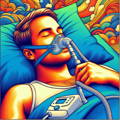The Role of Myofunctional Therapy in Managing Adult Snoring and Apnea
Your Ottawa Guide to Natural Sleep Improvement (2025)
“Current literature demonstrates that myofunctional therapy decreases AHI by approximately 50% in adults and 62% in children.”
— Stanford Health Care
(AHI = Apnea-Hypopnea Index, a key measure of sleep apnea severity)
Audience: Adults with sleep apnea/snoring, parents seeking non-invasive solutions, dentists, sleep specialists
Read time: 5 minutes
Key takeaway: Targeted tongue and airway exercises significantly improve airway stability, reduce apnea events, and complement other sleep therapies without surgery or medication.
Why Sleep-Disordered Breathing Matters
| Fact | What It Means |
|---|---|
| 1 in 5 adults has mild-to-moderate sleep apnea; many remain undiagnosed. | Fatigue, mood swings, and health risks go unnoticed or untreated. |
| Snoring and apneadisrupt sleep quality, causing fatigue, cognitive issues, and long-term health concerns. | Poor sleep isn’t just noisy—it’s harmful. |
| 50% of sleep apnea patients struggle with CPAP compliance. | Alternatives like myofunctional therapy become crucial for sustained health improvements. |
How Myofunctional Therapy Helps Improve Sleep
OMT is a form of physical therapy for oral and facial muscles, aiming to correct improper functions like tongue posture, swallowing, and breathing habits through specific exercises. It's essentially neurological re-education to normalize craniofacial structures and function.
| OMT Target Area | What We Do | Result for Your Sleep |
|---|---|---|
| Tongue Posture | Exercises to retrain tongue position and muscle tone | Prevents airway blockage by reducing tongue collapse |
| Soft Palate and Throat Muscles | Targeted strengthening movements | Less tissue collapse, reduced snoring and apnea episodes |
| Nasal Breathing | Nasal breathing drills and habit-building exercises | Decreases reliance on mouth breathing, promoting deeper, quieter sleep |
| Lip Closure & Jaw Stability | Exercises to support closed-mouth posture during sleep | Fewer disruptions, better sleep continuity, improved comfort |
Signs You Could Benefit from OMT for Sleep

Frequently snoring or noisy breathing
Morning dry mouth
Difficulty tolerating CPAP masks
Feeling exhausted even after 7+ hours of sleep
Brain fog or memory difficulties
Waking abruptly or frequently during the night
Daytime fatigue or difficulty concentrating
What a Typical OMT Sleep Program Looks Like (Overview)
1 - Initial Assessment –
A detailed consultation to evaluate airway function, oral posture, and breathing patterns.
2 - Customised Exercise Plan –
A simple, daily set of exercises designed specifically for your sleep-breathing needs.
3 - Regular Progress Reviews –
Brief check-ins to monitor improvement, adjust exercises, and ensure effectiveness.
4 - Collaboration with Healthcare Providers –
Regular communication with your sleep physician, dentist, or ENT to coordinate your overall care plan.
(Full exercises and instructions are provided individually and tailored specifically to your condition.)
Beyond the Basics: 5 OMT Exercises for Better Sleep & Airway Health
| Exercise | What It Trains | Why Your Airway Benefits |
|---|---|---|
| “Tongue-to-Spot” Suction Hold | Tongue-palate seal, tongue muscle control | Maintains airway openness, reduces snoring |
| Soft Palate Elevation (“K” Sounds) | Soft palate strength, throat muscle tone | Reduces tissue collapse, fewer apnea episodes |
| Lip Taping Practice (daytime) | Lip closure, nasal breathing habit | Enhances nasal airflow, reduces mouth breathing |
| Diaphragmatic Breathing Drills | Respiratory muscle strength and coordination | Improves oxygen intake, stabilizes breathing patterns |
| Cheek Puff Exercise | Improves lip closure and control | Enhances the ability to maintain a closed mouth posture |
These targeted exercises form just part of a comprehensive sleep-focused OMT program.
Risks of Leaving Sleep-Disordered Breathing Untreated
- Increased cardiovascular and stroke risk
- Chronic fatigue and cognitive decline
- Elevated blood pressure
- Higher risk of diabetes and obesity
- Impaired immune function and mood disorders
Frequently Asked Questions
Q: Can OMT completely replace CPAP?
A: No. For mild to moderate apnea, OMT may significantly reduce symptoms. Severe cases often benefit from a combined approach, reducing CPAP pressures and improving comfort.
Q: How quickly will I see results?
A: Many patients report improvements in sleep quality within the first 3 months of regular exercises.
Q: Is myofunctional therapy painful or difficult?
A: No. Exercises are gentle, easy to learn, and designed for comfort and convenience.
Case Snapshot — “Jamie,” 42, Ottawa
| At Intake | After 4 Months | After 8 Months |
|---|---|---|
| Loud nightly snoring, waking tired with headaches, difficulty with CPAP mask | Snoring noticeably quieter, fewer headaches, improved energy levels | Significantly reduced snoring, better CPAP tolerance, waking refreshed and energetic |
A consistent OMT routine can make a noticeable difference in sleep quality and daytime vitality, as Jamie experienced. Results vary and depend on many factors which are unique to each individual.
Take the First Step Toward Better Sleep
Book your free 45-minute consultation today at Oral-Facial Advantage in Ottawa. We’ll discuss your sleep concerns, outline how OMT can specifically help you, and begin your path toward restful nights and healthier days.
References
Cleveland Clinic. "What Is Myofunctional Therapy?"
Camacho M, et al. "Myofunctional Therapy to Treat Obstructive Sleep Apnea: A Systematic Review and Meta-analysis." Sleep, 2023.
Mayo Clinic. "Sleep apnea - Diagnosis and treatment."
Updated May 27, 2025. Check annually for the latest insights, evidence, and local Ottawa resources.
This blog post is based on current research in orofacial myofunctional therapy and clinical experience. Individual results may vary. Always consult with qualified healthcare providers for personalized treatment recommendations.



